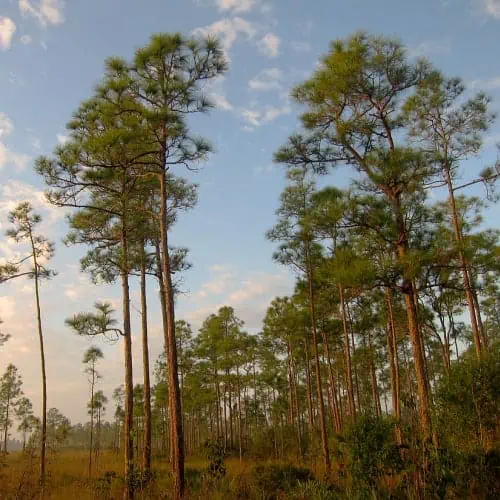
While Florida has come to be officially known as the “sunshine state”, and understandably so, its climate still varies drastically depending on the location in the peninsula as well as the time of year. There are more than eighty distinct ecosystems within the 500-mile-long and 160-milewide landscape, allowing for well-adapted, intriguing floral and faunal species to inhabit each (and leave viewers to their amazement).
As apparent with the nearly 3,000 native plant species to Florida, it seems as though acclimatization was successful and left the state littered with vivid, luscious flowering plants, beautifully textured shrubs, and dense, complex trees, all entirely unique from the next.
When determining the best planting options for a Florida backyard, it is imperative to take into account the inevitable dry spell that rolls back around each year. More often than not, native flora will be drought-tolerant as well as moisture-tolerant, allowing for some wiggle room when crafting an idealistic landscape. Below is a list of flowering plants, trees, and shrubs to pluck from that can combine to build a backyard right out of a magazine cover, despite the volatility that can occur within Florida’s various regions.
1) Buttonwood (Conocarpus erectus)

Buttonwood is a diverse, popular, multi-trunked tree that comes in two color morphs: silver and green. The green morph is sought after as it gives a traditional tree appearance, whereas silver buttonwood is smaller, denser, and displays more of a shrub form (especially when trimmed). Both types can quickly reach a size between twenty and forty feet for both width and height given enough sun and nutrients.
The perennial tree gets its name from the fruit that is produced throughout the year: clusters of spiky, brownish, leather-like buttons! Many fans of this species consider it to be the “fourth mangrove tree” since it is often found growing directly inland from mangrove swamps where less water permeates the soil.
2) Blanket flower (Gaillardia pulchella)
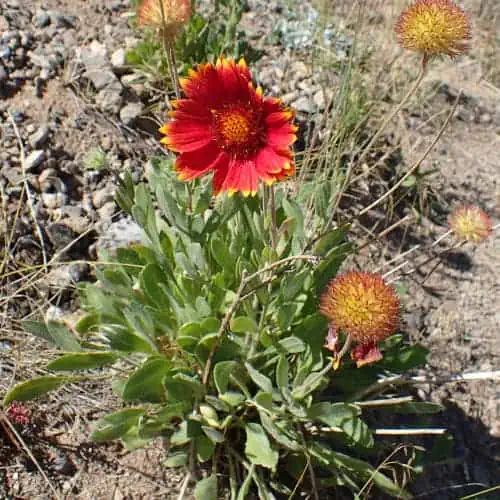
The blanket flower is a stunning annual flower, displaying vibrant hues of yellow, red, and orange. While not native to Florida as once previously thought, this plant fares excellently in the various ecosystems throughout the entire state. You can find this plant naturally in areas where there is plenty of salt spray and minimal ground moisture, yet it can also be planted in backyards with ease. Small birds travel to eat its seeds, and pollinators such as bees, butterflies, and wasps are attracted to its showy flowers. It was even believed that these flowers brought about good luck to those who cared for them!
3) American beautyberry (Callicarpa americana)
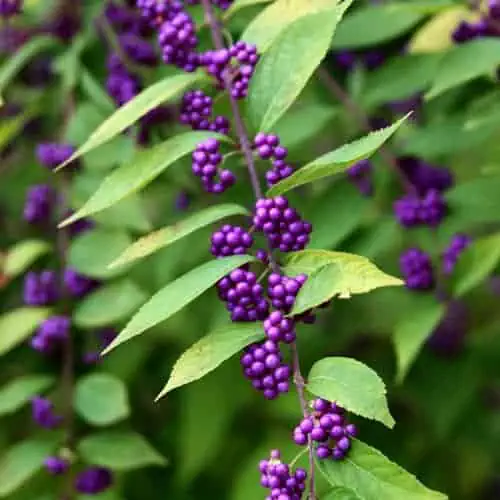
If looking for an ornamental piece that has flashy, magenta-colored fruit ripening every summer, beautyberry will do the job! Often used as a privacy screen or for mass ground cover, this drought-tolerant, long-lived perennial shrub has no problem soaking up the Florida sun. The berries on this bush can be utilized to make a grape-like jelly, but wild birds and deer feast straight from the plant. A staple medicinal plant for Native Americans, the American beautyberry contains natural chemicals within the leaves and roots that are known to ease dizziness and stomach aches, all while deterring mosquitoes and ticks!
4) Bay cedar (Suriana maritima)
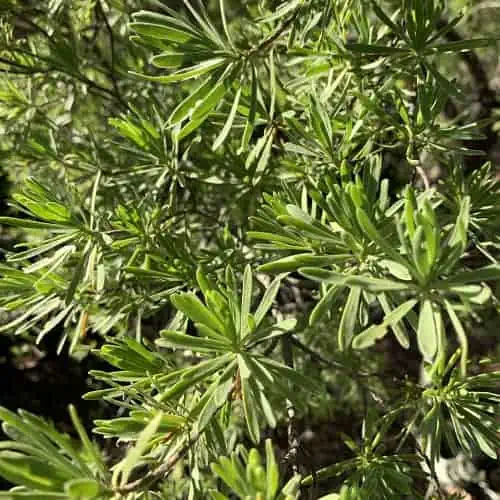
Endemic to only three regions in the northern hemisphere, the bay cedar tree can grow between 5 – 20 feet tall and produces small, yellow flowers all year. It grows moderately quickly in typical dense shrub fashion, so it is best used for backyards needing a uniform hedge look.
Bay cedars act as a host plant for the martial scrub hairstreak and mallow scrub hairstreak and are sure to attract other butterfly species as well, giving your backyard a true oasis feeling. Plant this evergreen perennial in a sandy substrate for the best results, though its hardiness allows it to flourish virtually anywhere in the state of Florida.
5) Firebush (Hamelia patens)
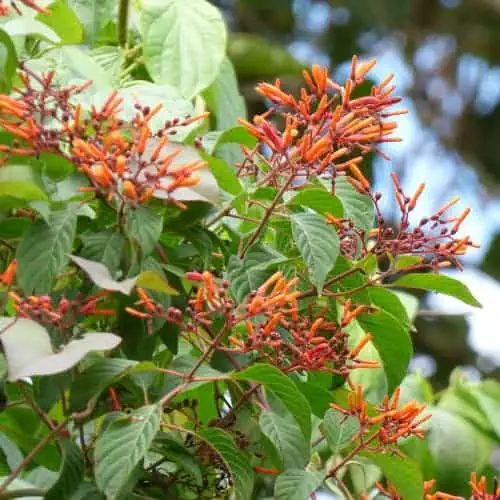
Though native to southern Florida, this fast-growing, adaptable shrub has the potential to become invasive if not maintained responsibly outside of its native range. Despite this warning, firebush is widely popular in the state thanks to its ease of planting, gorgeous, red, conical flower clusters, and low demand for moisture.
Hummingbirds frequent these shrubs for nectar, whereas birds and small mammals prefer the fruits. South Florida gets to see firebush bloom year-round thanks to the warm temperatures. However, it can resprout efficiently after particularly cold winters farther north.
6) Pitcher sage (Salvia azurea)
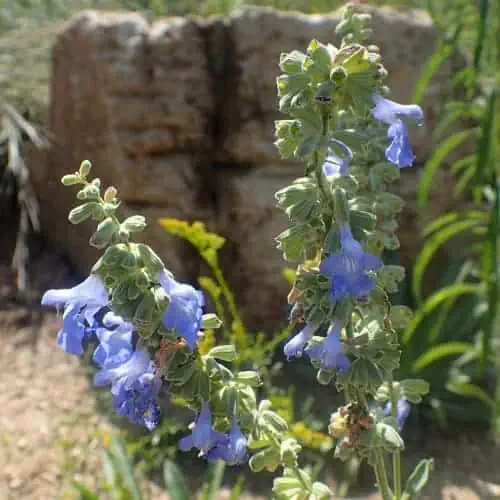
Also commonly referred to as “blue sage” and “azure blue sage”, this flowering plant remains dormant in winter and from July until October, royal blue and white flower clusters bloom along a single terminal spike. It is simple to grow this perennial as it establishes itself in a wide range of soil types that drain well and remain moderately dry. This plant is even able to double its root system in response to severe drought conditions! Being a member of the mint family, pitcher sage has been traditionally used as a natural medicine to relieve pain.
7) Saw palmetto (Serenoa repens)
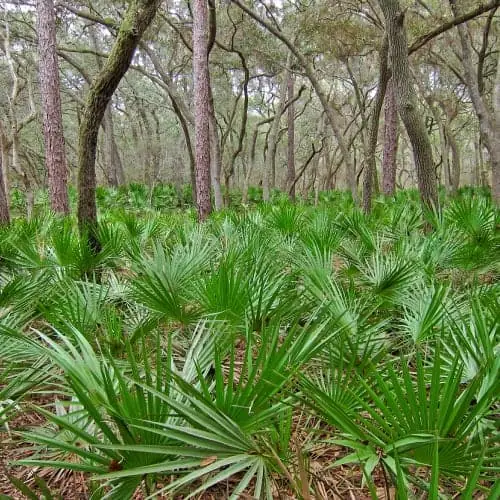
Looking like a short, dense palm tree, saw palmetto is an evergreen shrub that is drought tolerant, resistant to insects, and has even adapted to fire by resprouting and flowering quickly. One of the most diverse plants on this list, saw palmetto is used by a significant amount of wildlife for nesting, protection from predators, and as a food source. Even humans find benefits from this palm in its abilities to support prostate health and urinary health, decrease inflammation, and combat hair loss. The leaves are frequently harvested to create thatch roofing and baskets. Once established, saw palmetto is low maintenance, requiring little water and pruning.
8) Seagrape (Coccoloba uvifera)

As per the name, seagrape produces edible fruit from spring through the end of summer that closely resembles a bunch of green grapes. Its leaves are large and round, and grow in red until the chlorophyll develops to change the shade to green. Though not particularly tasty for humans, birds and small mammals will seek the fruits out.
Fast-growing and highly adaptable, seagrape would make an excellent choice for a Floridian’s backyard due to its unique appearance and simple maintenance. And whether you’re interested in owning a tree or a bush, seagrape can be trimmed to appear both ways!
9) Longleaf pine (Pinus palustris)
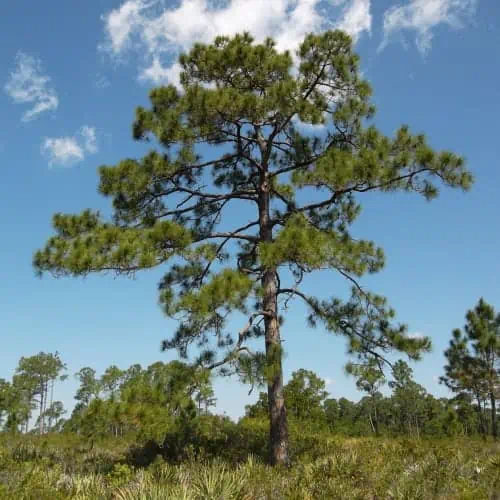
A tall evergreen tree (growing upwards of 150 feet), longleaf pine can live longer than 200 years and produces cones every spring. So long as cleaning up large cones frequently littering the grass is feasible, it is a beautiful shade tree for a larger backyard and is capable of withstanding both extremely dry periods and temporary flooding. Plant in full sun and enjoy a slow-growing tree that provides a habitat for nesting raptors, birds, and squirrels.
10) Red cedar (Juniperus virginiana)
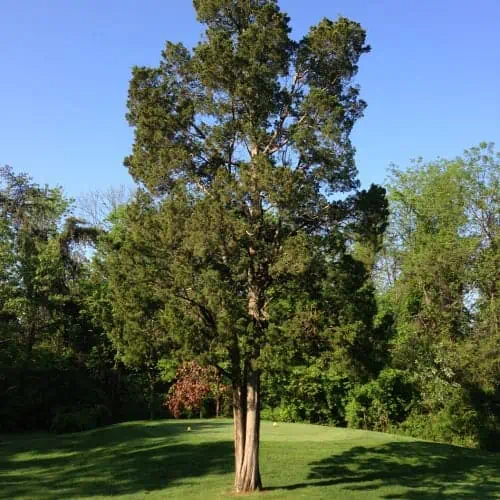
An elegant statement piece for a larger backyard would be a red cedar tree. Dense foliage, light blue berry-like fruits, fast-growing, and able to tolerate an array of environmental factors, this member of the cypress family makes the perfect addition to a landscape in need of texture and perhaps a privacy screen.
It is ideal to plant a small tree and water it consistently until established. From there, red cedar will be resistant to dry periods, and you can prune as desired. Considering Florida’s mild winters, residents of the state even opt to prune their red cedars to look like Christmas trees and decorate them accordingly to celebrate the holiday season!
11) Soap aloe (Aloe maculata)

Succulents are known for their tolerance against drought periods; in fact, they prefer well-drained soils to maintain a healthy root system. Sun-loving and hardy, soap aloe also provides the benefit of having thick, spotted leaves and beautiful bloom stalks that can grow as tall as 3 feet, filled with bundles of red, orange, or yellow flowers.
Hummingbirds will frequently consume its nectar, only contributing to the beauty of this plant. Ensure there is plenty of drainage for Florida’s rainy season if planting in the ground as rain is inevitable. They also fare well in wide pots if pups are cut out and propagated elsewhere as needed. If given enough time, soap aloe could make a superb groundcover plant for any backyard in Florida.
12) Bulbine (Bulbine frutescens)
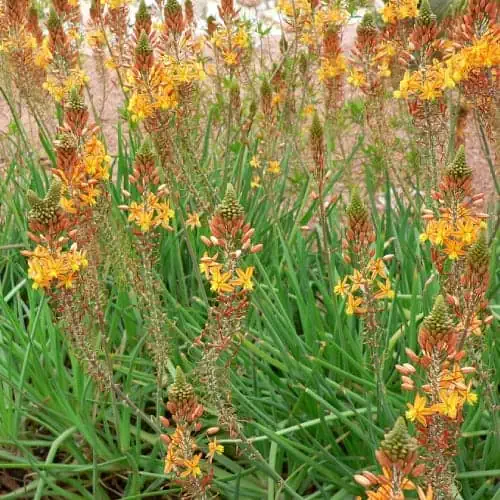
Don’t be shy toward rock gardens with bulbine in consideration. All species variations of bulbine do best in dry, well-draining soils and require deep watering only once per week! This flowering plant has leaves that stay clumped and extend upwards, looking similar to grass but in a thick, succulent nature.
In the warm Florida climate, this plant is likely to bloom year-round, displaying wispy yellow flowers packed onto tall, thin stalks standing above the foliage. Cutting back fading flower clusters can encourage additional blooms and tidy up the overall appearance. The leaves’ “jelly juice” has traditionally been used to treat burns, rashes, insect bites, and other skin ailments, proving useful to keep around in the backyard if not for looks alone.
13) Eastern prickly pear (Opuntia humifusa)

Prickly pear is part of the cactus family, and its unique, sprawling appearance can make a beautiful centerpiece for any Florida backyard! These plants grow no larger than two feet tall, but they can produce a plethora of fleshy pads (stems) that create a shrub-like appearance. Bright yellow flowers with an orange center bloom at the start of every summer and the fruits can even be eaten for a bitter taste.
Well-drained soils are ideal for the prickly pear cactus, and their tolerance to drought and freeze provides an efficient alternative to other flowering species. Much like other cactus species, eastern prickly pear has needles that can easily puncture human skin, so be aware of your surroundings when removing pads for your desired look.
14) Coontie (Zamia integrifolia)
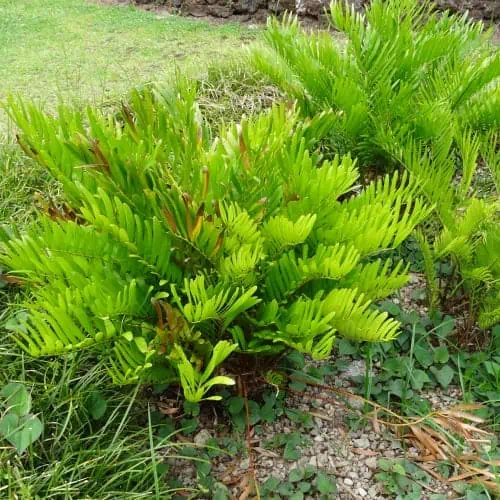
Sometimes mistaken for a fern or even a palm, coontie is a small cycad that only grows to a maximum height of three feet. Its stiff, upward-turned leaves provide a layered fan-like look that attracts the rare Atala butterfly! This plant is extremely slow growing which makes it more expensive in stores, but its resistance to dry spells, cold weather, and overall ease of care only contributes further to its demand. Coontie provides a clean, captivating look to any landscape that doesn’t require any pruning (other than the occasional dead leaf).
15) Cocoplum (Chrysobalanus icaco)
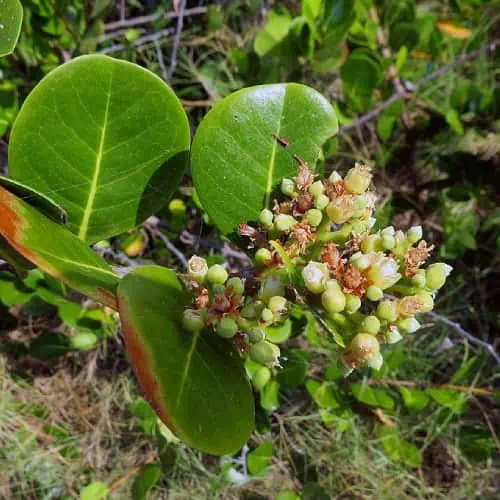
This tall and wide perennial shrub is perfect for lining fences to provide privacy in the backyard. With dark green, oval leaves, tiny clusters of white flowers, and pink fruits ripening to a deep purple throughout the year, this intriguing plant adds bountiful texture to any scape. They are propagated by seeds or hardwood cuttings and will suffice whether planted in full or partial sun.
Medium to large birds alongside mammals will frequent this bush seeking out its fruits or protection from predators. Even bees will visit, pollinating the blooming flowers themselves! Consuming the fruit for yourself is possible too, though it’s most popularly made into a jelly to pair with a hearty breakfast.
16) Dreadlock croton (Codiaeum variegatum)

Looking for a plant that provides a flashy array of colors, is drought-tolerant, and has long, spiraling leaves for the ultimate “paradise” feeling? Dreadlock croton fits all these criteria and more! It habitually forms a shrub and will remain colorful the entire year, allowing any space occupied by this plant to shine. If planted in a backyard, butterflies will frequent it, but ensure that any pets avoid it. The leaves and roots are poisonous to humans and pets if ingested, so it is best to leave this perennial just for viewing purposes.
To trim, snip just above a node to allow the plant to regrow from this section. With hundreds of croton plant varieties all occurring under one species due to the plant’s genetic variability, any classification is sure to impress passersby and visitors alike, though the dreadlock variation is not one to miss out on.
17) Florida privet (Forestiera segregata)
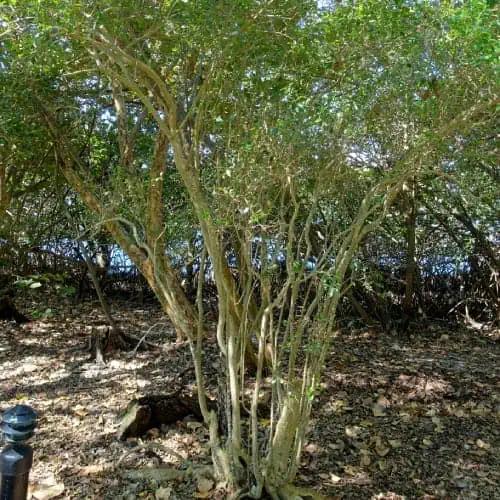
Utilized as a small tree or large shrub, Florida privet is a widely cultivated plant within Florida that grows quickly and provides a successful privacy screen for backyards considering its 15-foot height potential. The bark is often pale and smooth, contrasting with the forest green leaves that form a dense network.
It is best left in full sun conditions with well-draining soil to tolerate both wet and dry seasons. Greenish-yellow flowers will bloom year-round, though these minute groups will be most notable in the spring. Interestingly enough, Florida privet (also referred to as swamp privet) has separate male and female individuals, making this olive family plant even more exclusive to own.
18) Florida thatch palm (Thrinax radiata)
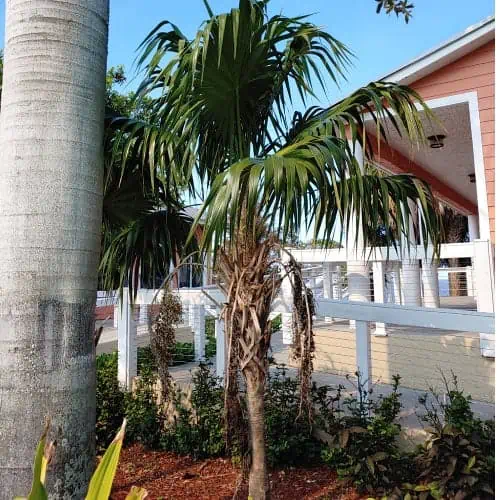
Whether you’re looking for a centerpiece palm for a pot or a garden, this smaller palm is sure to leave a lasting, coastal feel that truly screams “Florida”. It only grows to twenty feet tall with yellowish fronds fanning out from the skinny trunk, creating a wispy, beautiful appearance. After producing long inflorescences, thatch palm will then develop fruit that turns white when ripened (birds will flock to feast on these miniature fruits.) This palm will not overcrowd a space nor act as a pest for any landscape due to its slow growth rate.
Well adapted to Florida’s high pH soils and the state’s dry periods, it will mature well in any setting so long as it’s given full sun. Florida thatch palm is on the list of endangered species that are protected in Florida, so ensure purchases are made from trusted local nurseries that do not collect wild specimens. If you’re interested in propagating your own, the seeds from this palm almost always germinate!
19) Pineland lantana (Lantana depressa)
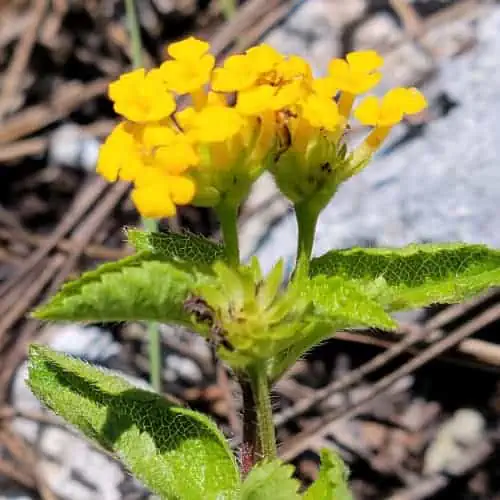
An endemic species to southern Florida, the pineland lantana (gold lantana) is sure to add plenty of life to a seemingly dull backyard thanks to its packed shrub formation topped with nectar-packed, golden-yellow inflorescences. An evergreen perennial, pineland lantana will grow wider rather than taller, making it a perfect choice for ground coverage.
Soil moisture should remain low and be well-drained to counteract Florida’s wet season. This plant has no problem with drought, but scheduled watering with proper soil will allow it to flourish further. Cut long strands back to facilitate a denser look, but otherwise minimal care is needed. It is recommended to have a fenced-in backyard since the leaves and unripened berries are poisonous to grazing and curious animals.
20) Lignum vitae (Guaiacum sanctum)
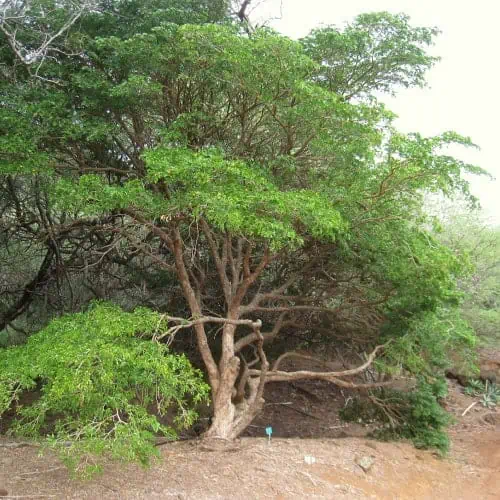
Widely known as the “tree of life” and “holywood”, this evergreen reminds one of bonsai trees due to its winding array of trunks and lush canopy. It adds a pop of life to backyards with its significant star-shaped flowers bunched into terminal clusters, all radiating a vibrant, light purple-blue hue year-round. The fruit produced from this plant in the summer is also flashy and elegant, sporting a vivid yellowish-orange color.
While not known to attract any wildlife, the beauty of lignum vitae should not be overlooked. Its lengthy maturation rate allows plenty of time to prune as necessary and its ability to tolerate drought, wind, salt, and other environmental factors make growing this tree as easy as pie. Rare today (though still possible to find at local tree farms), lignum vitae has been widely overharvested for its once-popular uses in crafting gears, mallets, and propeller shafts for ships.


I’ve got a dry parched angled spot in the backyard that I may use these idea(s) to populate. Thanks so much.